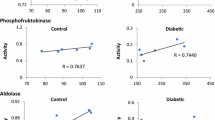Abstract
-
1.
By column chromatography on DEAE-cellulose calcium phosphate mixed gel red cell catalase can be separated in two fractions, 0.15 M saline and 0.15 M secondary phosphate being used as eluants.
-
2.
The fractions obtained from blood of normal subjects and of homozygous acatalasia cases differ in electrophoretic mobility and in heat stability. Of the fractions isolated from blood of heterozygous cases, one resembles electrophoretically the normal and the other the acatalatic enzyme.
-
3.
The observation that the enzyme fractions isolated from acatalatic blood are less stable and are mainly localized in reticulocytes, suggests, that in acatalasia a labile enzyme variant is synthesized. Therefore, acatalasia may be considered as an enzyme defect due to a structural gene mutation.
Zusammenfassung
-
1.
Unter Verwendung eines Gemisches von DEAE-Cellulose-Calciumphosphat-Gel, läßt sich Erythrocytenkatalase in zwei Fraktionen trennen, wobei sich eine durch 0.15 M NaCl, die andere durch 0,15 M sekundäres Phosphat eluieren läßt.
-
2.
Die aus Blut normaler Versuchspersonen und homozygoter Akatalasiefälle dargestellten Fraktionen unterscheiden sich hinsichtlich elektrophoretischer Beweglichkeit und Hitzestabilität. Von den beiden aus Blut heterozygoter Defektträger isolierten Fraktionen verhält sich die eine wie die Fraktionen aus normalem Blut, die andere wie diejenigen aus Akatalasieblut.
-
3.
Der Befund, daß das aus Akatalasieblut isolierte Enzym relativ unbeständig ist und dieses vor allem in den Reticulocyten vorkommt, berechtigt zur Annahme einer labilen Enzymvariante. Es scheint sich demnach bei den hier untersuchten Fällen von Akatalasie um die Mutation eines Strukturgens zu handeln.
Similar content being viewed by others
Bibliography
Aebi, H., u. H. Suter: Über die Peroxidempfindlichkeit von Akatalasie-Erythrocyten. Humangenetik 2, 328–343 (1966).
—, u. M. Cantz: Über die celluläre Verteilung der Katalase in Blut homozygoter und heterozygoter Defektträger (Akatalasie). Humangenetik 3, 50–63 (1966).
Thorup, O. A., J. T. Carpenter, and P. Howard: Human erythrocyte catalase: Demonstration of heterogeneity and relationship to erythrocyte ageing in vivo. Brit. J. Haemat. 10, 542–550 (1964).
Holmes, R. S., and C. J. Masters: Catalase heterogeneity. Arch. Biochem. 109, 196–197 (1965).
Aebi, H., M. Baggiolini, B. Dewald, E. Lauber, H. Suter, A. Micheli, and J. Frei: Observations in two swiss families with acatalasia II. Enzymol. biol. clin. 4, 121–151 (1964).
Micheli, A., et H. Aebi: Recherche immunochimique de la catalase erythrocytaire dans l'hemolysat acatalasique. Rev. franç. Étud. clin. biol. 10, 431–433 (1965).
Aebi, H.: Analysis of residual blood catalase activity from the acatalatic condition (acatalas(em)ia); Comm. Int. Congr. of Biochemistry 1964 New York (abstract III-2).
Matsubara, S., H. Suter, and H. Aebi: Heterogeneity of catalase in blood of heterozygous cases of acatalasia. Experientia (Basel) 22, 428–429 (1966).
Aebi, H., C. H. Schneider, H. Gang, and U. Wiesmann: Separation of catalase and other red cell enzymes from hemoglobin by gel filtration. Experientia (Basel) 20, 103–104 (1964).
Poulik, M. D.: Starch gel electrophoresis in a discontinuous system of buffers. Nature (Lond.) 180, 1477–1479 (1957).
Grabar, P.: Immunoelectrophoretic analysis. Meth. biochem. Anal. 7, 1–38 (1959).
Thorup, O. A., W. S. Strole, and B. S. Leavell: A method for localisation of catalase on starch gels. J. Lab. clin. Med. 58, 122–128 (1961).
Feinstein, R. N.: Perborate as a substrate in a new assay of catalase. J. biol. Chem. 180, 1197–1202 (1949).
Ouchterlony, Ö.: Antigen-antibody reactions in gels III. Arkh. Kemi 1, 55–59 (1949).
Matsubara, S., and H. Suter: In preparation.
Dawson, D. M., H. M. Eppenberger, and N. O. Kaplan: The comparative enzymology of creatine kinases; Physiological and chemical properties. J. biol. Chem. 242, 210–217 (1967).
Feinstein, R. N., J. T. Braun, and J. B. Howard: Acatalasemic and hypocatalasemic mouse mutants; II. Mutational variations in blood and solid tissue catalases. Genetics (in press).
Cantz, M., and H. Aebi: In preparation.
Goedde, H. W., u. E. Schoepf: Pharmakogenetik (Klinische Probleme und biochemisch-genetische Grundlagen). Med. Klin. 59, 1849–1860 (1964).
Schroeder, W. A., J. R. Shelton, J. B. Shelton, and B. M. Olson: Some amino acid sequences in bovine liver catalase. Biochim biophys. Acta (Amst.) 89, 47–65 (1964).
Samejima, T., and K. Shibata: Denaturation of catalase by formamide and urea related to the sub-unit make-up of the molecule. Arch. Biochem. 93, 407–412 (1961).
Feinstein, R. N., J. E. Seaholm, J. B. Howard, and W. L. Russell: Acatalasemic mice. Proc. nat. Acad. Sci. (Wash.) 52, 661–662 (1964).
Author information
Authors and Affiliations
Additional information
This is contribution No. 3 of a series of papers on acatalasia published in this journal [1,2].
Rights and permissions
About this article
Cite this article
Matsubara, S., Suter, H. & Aebi, H. Fractionation of erythrocyte catalase from normal, hypocatalatic and acatalatic humans. Hum Genet 4, 29–41 (1967). https://doi.org/10.1007/BF00279177
Received:
Issue Date:
DOI: https://doi.org/10.1007/BF00279177




